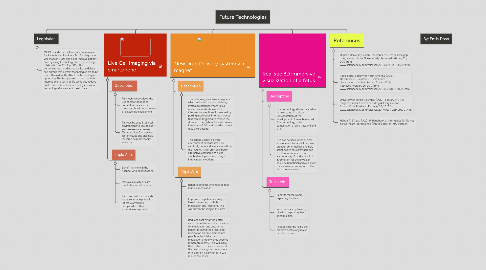
1. References
1.1. Uppsala University. (2016, December 21). Live cell imaging using a smartphone. ScienceDaily. Retrieved February 26, 2017 from www.sciencedaily.com/releases/2016/12/161221141329.htm
1.2. Radiological Society of North America. (2016, November 21). Realistic 3-D immersive visualization of unborn babies. ScienceDaily. Retrieved February 26, 2017 from www.sciencedaily.com/releases/2016/11/161121180322.htm
1.3. University of British Columbia. (2017, February 14). Tiny magnetic implant offers new drug delivery method. ScienceDaily. Retrieved February 26, 2017 from www.sciencedaily.com/releases/2017/02/170214092701.htm
1.4. Hebda, T. & Czar, P. (2013). Handbook of Informatics for Nurses & Healthcare Professionals (5th Ed.). Boston, MA: Pearson.
2. Realistic 3D immersive visualization of a fetus
2.1. Description
2.1.1. This technology allows for a fetus to be created in a visual representation of the development of an unborn child. This technology is the combination of an ultrasound and a MRI.
2.1.2. This can be used in the clinical environment because it can see prenatal abnormalities and help assist health care providers see the development in a more accurate way. Providing a lot of information for the physician could be beneficial and also allow the necessary precaution of the fetus' development.
2.2. Triple Aim
2.2.1. Benefits mothers and expecting families.
2.2.2. Improves care by treating physical respiratory tract abnormalities.
2.2.3. Reduces cost by fixing the problem before any major problem occurs.
3. Live Cell Imaging via smartphone
3.1. Description
3.1.1. This technology allows the use of smartphones to record live data such as moving cells without the use of a expensive equipment
3.1.2. This can be used in clinical environment to use to see if any diseases are present. This can allow for possible faster results and also help research be more readily available
3.2. Triple Aim:
3.2.1. Benefits anyone in the hospital who needs testing.
3.2.2. Improves quality of care due to faster test results
3.2.3. Reduces cost for hospitals because a smartphone is a lot more affordable compared to other expensive equipment
4. New Drug Delivery system via magnet
4.1. Description
4.1.1. This technology involves a magnet in which will assist the drug delivery system to patients whom takes numerous medication and/or intravenous injections. It's worked by putting medication into the magnet that can be triggered to release the dose into the system. This will prevent infections of IV's and help the patient take their dosage.
4.1.2. This can be used in a clinical environment because it will be surgically done and administered into the magnet. It will provide a better alternative compared to being stabbed multiple times through intravenous injections.
4.2. Triple Aim
4.2.1. Benefits patients who need to take multiple medication
4.2.2. Improves the patients quality of life of preventing multiple medication and injections. This will prevent bruising in the arms
4.2.3. Reduces cost by giving better care. This will reduce doctor visits for medication and ensure the patient is taking the prescribed medication on time. Sometimes, people will not take the medication properly, thus become ill more frequently. This will make them return to the clinic and cost the healthcare system even more. If this option is eliminated, it will reduce the costs.
